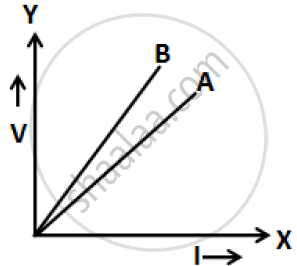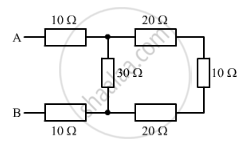Advertisements
Advertisements
प्रश्न
Three resistors of 6Ω, 3Ω and 2Ω are connected together so that their total resistance is greater than 6Ω but less than 8Ω Draw a diagram to show this arrangement and calculate its total resistance.
उत्तर
We connect the resistance of 3 Ω and 2 Ω in parallel to each other and then connect this (parallel combination) to the 6 Ω resistance in series. The required arrangement is as shown in given figure. The equivalent resistance of 3Ω and 2 Ω in parallel.
`1/"R" = 1/3 + 1/2 = (2 + 3)/6 = 5/6`
or R = `6/5`Ω = 1.2 Ω
Thus, the total resistance of the set up is (1.2 + 6) Ω = 7.2 Ω
APPEARS IN
संबंधित प्रश्न
The V-I graph for a series combination and for a parallel combination of two resistors is shown in the figure below. Which of the two A or B. represents the parallel combination? Give reasons for your answer.

How does the presence of impurities in a metal affect its resistance?
Give one example to show how the resistance depends on the nature of material of the conductor.
The diagram below shows part of a circuit:

If this arrangement of three resistors was to be replaced by a single resistor, its resistance should be:
(a) 9 Ω
(b) 4 Ω
(c) 6 Ω
(d) 18 Ω

Choose the correct alternative and rewrite the following sentence.
If three resistors 2 ohms, 3 ohms and 4 ohms are connected in series, then the effective resistance in the circuit will be _______ ohms.
Answer the following question.
While studying the dependence of potential difference ( V) across a resistor on the current (I) passing through it, in order to determine the resistance of the resistor, a student took 5 readings for different values of current and plotted a graph between V and t. He got a straight line graph passing through the origin. What does the straight-line signify? Write the method of determining the resistance of the resister using this graph.
Why are thick copper wires used as connecting wires?
